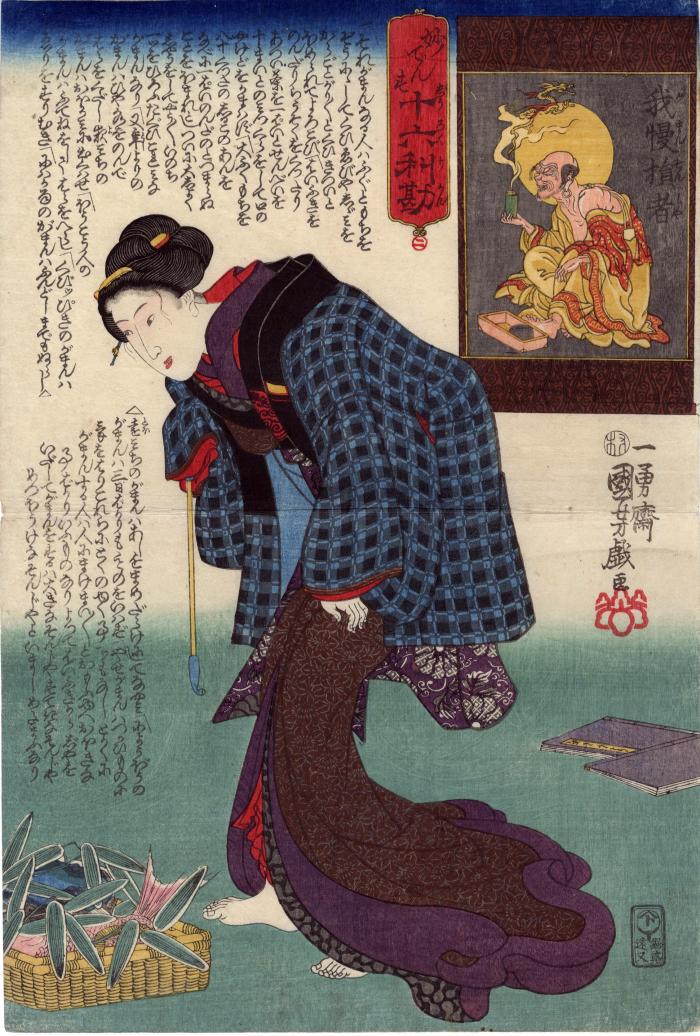Utagawa Kuniyoshi (歌川国芳) (artist 11/15/1797 – 03/05/1861)
No. 2, Gaman Sonja (我慢損者 - The Impatient Loser) from the series Sixteen Wonderful Considerations of Profit (Myō densu jūroku rikan - 十六利勘 我慢損者)
ca 1845
9.75 in x 14.375 in (Overall dimensions) Japanese woodblock print
Signed: Ichiyūsai Kuniyoshi giga
一勇斎国芳戯画
Artist's seal: kiri
Publisher: Enshūya Matabei
(Marks 057 - seal 22-009)
Censor's seal: Mura
National Diet Library
Museum of Fine Arts, Boston
British Museum
Minneapolis Institute of Arts - entitled 'Be Patient'
Waseda University
Victoria and Albert Museum
Tokyo Metropolitan Library The ending of Kuniyoshi's signature, giga, indicates that this print is meant to be viewed as something witty or even comical. While the deeper significance of this holy man with the beautiful woman might elude us we know there must be a message in there somewhere. Does this have to do with the woman's apparent interest in the basket lying at her feet with the red tai in it among a grouping of plants with long leaves? How does this relate to the arhat who appears to be conjuring up a dragon?
Robert Schaap deals with this same issue of humor in this series in his Heroes and Ghosts... (p. 136):
"Kuniyoshi's signature, Ichiyūsai Kuniyoshi giga, ('comic picture by Ichiyūsai Kuniyoshi'), is the first indication that there is more to this print than meets the untrained Western eye. The first clue to the underlying humour is seen in the kakemono ('hanging scroll') in the background. It illustrates a rakan (Sanskrit: arhat), a Buddhist disciple released from the cycle of rebirth... The number of arhat can vary from sixteen to 500, with the configuration of sixteen arhat being a return to the Indian Hindu tradition in which it represents 'perfection.'"
****
The term 'gaman' (我慢) can be translated as 'patience; endurance; perseverance; tolerance; self-control or self-denial. 'Gaman' can also be a family name.
The University of Vienna provides a transliteration of the text on this print: Sore gaman naru hito wa fugu to mochi o zōni ni shite kui ebi ya shijimi o karagoto garigari to kui kitsui to homerarete yorokobi haifuki o nondari rōsoku o kuttari atsui cha o ippai to senbei o jūmai to nomikkura o shite kuchi no yakedo o kamawazu daifukumochi o hachijū kutta no shiruko no an o nabe ni ippai nonda no to tsumaranu koto o homare to shi tsui ni daishokushō o shite yōyō inochi hitotsu o hirou tagui kore mina gaman nari mata toshiyori no gaman wa hiyamizu o nonde hara o kudashi yomichi no gaman wa ōkami ni dekuwase hōkōnin no gaman wa futene o shite hara o herashi kubippiki no gaman wa eri o surimuki niwakamono no gaman wa fundoshi made mo nurashi tōmichi no gaman wa ashi o mamedarake ni shite nayami nyōbō no gaman wa mikka bakari mo mono o iwazu yasegaman wa tsukaimono ni ki o hari korera ni toku no yuku koto hitotsu mo nashi tokaku ni gaman suru hito wa hito ni makemai makemai to omou yue ōki na koto bakari iu mono nari yotte haifuki kara ja o idashite gaman o suru wa ōki na sonja suteki na sonja metsubōge na sonja to imashimetamaunari
There commentary on this series and this particular print are especially interesting:
"After the edict (machibure) from the 6th month of 1842 which interdicted the bijinga (beauty-pictures), Kuniyoshi started to paint this type of pictures as giga (humorous pictures) in order to bypass the monitoring system of the authorities. The „16 illustrations of Arhat (十六羅漢 16 rakan) became “16 considerations of profit” (十六利勘 16 rikan), the “Buddhist saints” (尊者 sonja) became “damaged saints” (損者 sonja). Kuniyoshi produced in this series a very simple and straight logic about different characters of persons of that time, and presented them in a funny and cynical way. In this series of 16teen pictures two different types of censorship seal can be observed. Ten pictures are signed with “Murata”, six with “Mura”. In any case it indicates the person in charge for the censorship system, Murata Sahē. The researcher Iwakiri assumes, that the censor Sahē changed the seal from “Mura” two “Murata” during the printing of this series in the 10th month of 1846.
The Japanese proverb “Dragon out of the ash receptacle” has the same meaning as “A pony out of a gourd” namely, that something totally unpredictable is happening. The meaning of Kuniyoshi’s picture is something different. He tells the “saint damaged by endurance” deadly serious, that it is quiet uncomfortable for a dragon to endure in such a small place as an ash receptacle. At [sic] the notes on the picture all different kinds of endurances are listed, such as the “endurance of the aged”, the “endurance of the road at night”, the “endurance of the servants”, the “endurance of the neck-pulling-game”, the “endurance at a pelting rain”, the “endurance at a long path”, the “endurance of the wife” or the “endurance when you do not want to show that you can not endure any longer”. All these different kind of endurances are of no use at all but are harmful and that is why we are told never to endure. Kuniyoshi presents the fundamental idea of the Tenpō-reform through the Confucian doctrine “endurance means to endure the unendurable” in a clear and cynical way."
****
The text reads: それがまんなる人ハふぐともちを ぞうにゝにしてくひゑびやしゞミを からごとがりがりとくひきついとほめられてよろこび 「はいふきを のんだりらうそくをくったり あつい茶を一ぱいとせんべいを 十まいとのミっくらをして口の やけどをかまハず 「大ふくもちを八十くったの志るこのあんを なべにて一ぱいのんだのとつまらぬ ことをほまれとし ついに大しょく しやうをしてやうやういのち 一ッをひろふたぐひこれミな がまんなり 「又年よりの がまんハひや水をのんで はらをくだし 夜ミちの がまんハおほかミに出くハせ 「ほう
Enshūya Matabei (遠州屋又兵衛) (publisher)
beautiful woman picture (bijin-ga - 美人画) (genre)
mitate-e (見立て絵) (genre)
